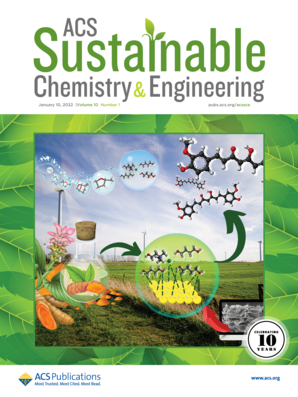Plasma-Driven Catalytic Conversion of Biogas to Methanol and Acetic Acid and the Role of Water in Tailoring Products
IF 7.1
1区 化学
Q1 CHEMISTRY, MULTIDISCIPLINARY
引用次数: 0
Abstract
The conversion of biogas, a widely available renewable source, to the desired liquid products under mild conditions still remains challenging. Integrating nonthermal plasma with catalysts makes it possible to produce acetic acid and methanol directly from biogas consisting mainly of CO2 and CH4. Among various catalysts examined, plasma-reduced Cu/Al2O3 with a flower-like morphology substantially enhances methanol formation. Adding a small amount of water vapor into biogas significantly enhances methanol production under cold plasma. In situ optical emission spectroscopy, probe tests with isotope-labeled D2O and H218O, and plasma desorption analysis provide clear evidence that water not only participates in and promotes the methanol-forming reaction but also facilitates methanol desorption from the catalyst surface under plasma. Increasing the plasma discharge power, however, can dramatically switch the liquid products from methanol-dominated to acetic acid-dominated oxygenates. These novel findings provide a new strategy for the direct conversion of biogas to chemicals and fuels.等离子体催化沼气转化为甲醇和乙酸及水在制衣产品中的作用
沼气是一种广泛可用的可再生资源,在温和条件下转化为所需的液体产品仍然具有挑战性。将非热等离子体与催化剂相结合,可以直接从主要由CO2和CH4组成的沼气中生产乙酸和甲醇。在所检测的各种催化剂中,等离子体还原的具有花状形态的Cu/Al2O3显著地促进了甲醇的形成。在低温等离子体条件下,向沼气中加入少量水蒸气可显著提高甲醇产量。原位光学发射光谱、同位素标记的D2O和H218O探针测试以及等离子体脱附分析表明,水不仅参与和促进了甲醇的生成反应,而且还促进了等离子体作用下催化剂表面甲醇的脱附。然而,增加等离子体放电功率可以显著地将液体产品从甲醇为主转变为乙酸为主的氧合物。这些新发现为直接将沼气转化为化学品和燃料提供了一种新策略。
本文章由计算机程序翻译,如有差异,请以英文原文为准。
求助全文
约1分钟内获得全文
求助全文
来源期刊

ACS Sustainable Chemistry & Engineering
CHEMISTRY, MULTIDISCIPLINARY-ENGINEERING, CHEMICAL
CiteScore
13.80
自引率
4.80%
发文量
1470
审稿时长
1.7 months
期刊介绍:
ACS Sustainable Chemistry & Engineering is a prestigious weekly peer-reviewed scientific journal published by the American Chemical Society. Dedicated to advancing the principles of green chemistry and green engineering, it covers a wide array of research topics including green chemistry, green engineering, biomass, alternative energy, and life cycle assessment.
The journal welcomes submissions in various formats, including Letters, Articles, Features, and Perspectives (Reviews), that address the challenges of sustainability in the chemical enterprise and contribute to the advancement of sustainable practices. Join us in shaping the future of sustainable chemistry and engineering.
 求助内容:
求助内容: 应助结果提醒方式:
应助结果提醒方式:


